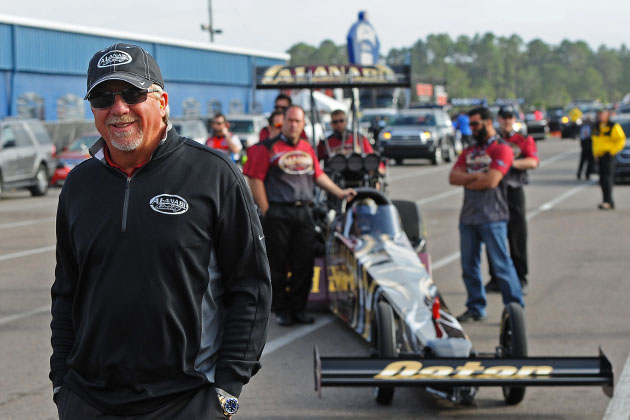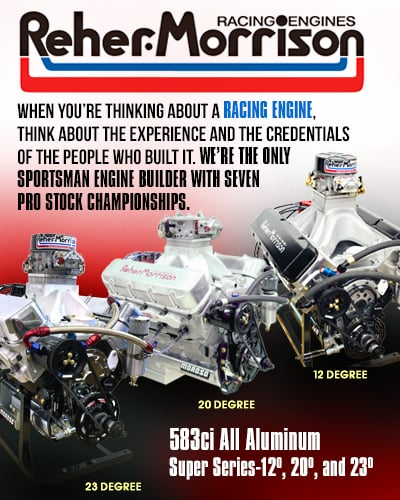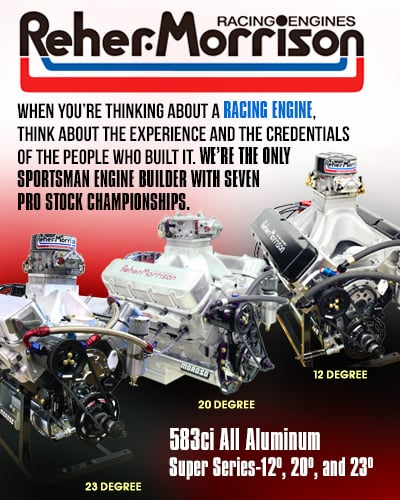ALAN JOHNSON SACRIFICED EARLY SEASON SUCCESS FOR NEW ENGINE COMBINATION
Alan Johnson understood the perception was going to be his team had lost their edge when the wins didn’t come quickly this season.
The iconic nitro tuner who manages the Al-Anabi Racing operation planned to take three steps back in order to take one huge leap forward into contention.
Essentially, the eight-time championship tuner with two as a team manager; stopped cold in his tuning path and chose to go in a different direction. This kind of about-face can be challenging for a person who has made success second-nature.
“It was pretty tough to begin with,” admitted Johnson. “When we resigned to the fact we were going to have to develop a whole new strategy and try and get ahead of everybody again, then I could accept it. We knew we were going to have to take our lumps and this would pay off in the end. Our whole mindset was to make sure we got to the top of our game when we got to Indy so that we could run the Countdown with the hopes we could win it. That’s what this thing is all about.”
Right now, the move is looking genius for Johnson, who has a championship ring for each finger on both hands and four toes (including his TAD days with brother Blaine), as he’s put Shawn Langdon into the Countdown and true nitro rookie Khalid alBalooshi into the 12th spot with quarter-final finishes in the last two events.
 Mark Rebilas/Toyota Racing
Mark Rebilas/Toyota Racing
 SIDEBAR - AJ THE SPEED MERCHANT
SIDEBAR - AJ THE SPEED MERCHANT
Speed equals horsepower. Alan Johnson knows how to make both.
In August 2005, as a tuner for Don Schumacher Racing, he guided Tony Schumacher to a 337.58 mph blast at Brainerd Raceway. Earlier this season DSR’s Spencer Massey established the 1,000-foot speed mark for the NHRA’s 1000-foot course at 332.18 mph.
Only 5.40 miles per hour separates today’s nitro racing on a shortened race track to the speeds NHRA Top Fueler dragsters reached when running it out the back door.*** Johnson said he could only guess where the speeds would be if they were still running to 1320 feet.
“That’s kind of hard to say because we run the cars a bit different now,” admitted Johnson. “We wouldn’t run the cars as aggressively as we do if we were trying to make them go to the quarter-mile. A 1320-foot run is pretty tough on the engine. The way we run them now … with the rev-limiter, it probably wouldn’t change at all. If we didn’t have a rev-limiter and we ran quarter-mile with the car we have now, I’m sure we’d run well over 340. With the rev-limiter, it’s not possible.”
Plus, as Johnson revealed, at most tracks back in the quarter-mile, the land-based rockets were slipping and sliding for the last 320 feet. The move to 1,000 foot race courses has made the driver the most important part of the equation.
“That last 320 feet, at a lot of tracks, we’d spin the tires,” said Johnson. “That generally doesn’t happen anymore. The tracks are really good, all the way to the 1,000 feet. Generally you don’t spin the tires there. There are some places you do when it is really hot. Generally, we don’t. The driver doesn’t have that extra 320 feet to make up for a bad reaction time. It’s put all of the cars a little closer together. There’s more emphasis on the driver whether they are going to win or lose.”
CLICK HERE TO READ FULL STORYAlan Johnson understood the perception was going to be his team had lost their edge when the wins didn’t come quickly this season.
The iconic nitro tuner who manages the Al-Anabi Racing operation planned to take three steps back in order to take one huge leap forward into contention.
Essentially, the eight-time championship tuner with two as a team manager; stopped cold in his tuning path and chose to go in a different direction. This kind of about-face can be challenging for a person who has made success second-nature.
“It was pretty tough to begin with,” admitted Johnson. “When we resigned to the fact we were going to have to develop a whole new strategy and try and get ahead of everybody again, then I could accept it. We knew we were going to have to take our lumps and this would pay off in the end. Our whole mindset was to make sure we got to the top of our game when we got to Indy so that we could run the Countdown with the hopes we could win it. That’s what this thing is all about.”
Right now, the move is looking genius for Johnson, who has a championship ring for each finger on both hands and four toes (including his TAD days with brother Blaine), as he’s put Shawn Langdon into the Countdown and true nitro rookie Khalid alBalooshi into the 12th spot with quarter-final finishes in the last two events.
When the NHRA U.S. Nationals resumes this Saturday, Langdon is third quickest and alBalooshi is sixth.
It appears Johnson’s plan is coming together at the right time.
“That was the plan,” Johnson confirmed. “We’ve worked really hard on a few things just to get here … probably pushed them a little faster than we should have just to have it ready. Are we perfect? No. We’ve got the rest of this event to go. We get to Charlotte which is typically a pretty good race track, and I think we are in pretty good shape.”
Johnson understands the importance of being on the cutting edge of drag racing technology, and even more so in the rough and tumble world of nitro racing. At the end of last season, Johnson drew the painful conclusion his championship proven combination didn’t enjoy the cushion it once did. This reality sent him to the drawing board to head in a different direction.
Johnson admits the challenge of abandoning the proven combination for the unknown wasn’t as unsettling as one might think.
“That’s part of the challenge – what makes it fun,” Johnson explained. “We had a really good tune-up that worked great. We did well with a second and two firsts [in the Countdown]. It was good but a lot of people caught up. The Don Schumacher teams were working on their stuff and a lot of teams that we supply parts to were getting creative. There were a lot of really good running cars.
“Starting the year with two new drivers mixed our team up a little bit. We figured this was the best time to pull the plug on the old tune-up and start with something different; we can hopefully get that edge. It doesn’t take much anymore. The cars are so close, we looking to get a few thousandths.”
Johnson said his new drivers rolled with the punches when it could have been easy to get frustrated. He said it was important everyone remained focused on the objective in order to bring the plan to fruition.
“These guys are all smart enough to know what we are doing,” said Johnson. “As they can see the incremental changes, and the things we are working on, and as they see the incremental change, they’re optimistic enough to know what it comes down to at the end of the year. We are going to be in a good position.”
Keeping his drivers focused was one thing, but how did a tuner who was accustomed to winning at the blink of an eye deal with the lack of success?
“I wasn’t frustrated at all,” Johnson said as he went on to praise his drivers.
“Shawn is doing a great job. If we had given him a decent car this year, he would have won some races. I’m sure he’s as frustrated as we are. He hasn’t won a national event yet. He hadn’t won a Top Fuel event and I’m sure he was licking his chops when he came over here to start winning. Then we started this new project and changing our tune-up just a few races into the season. He’s probably more frustrated than I am.
“With Khalid, I knew he was a rookie. He had never driven a dragster outside of license runs in the A/Fuel Dragster. I knew that was going to be a bit of the battle. He’s actually doing a good job now and getting better. Even though he’s not in the Countdown, he can be a spoiler.”
Johnson credits experience as his confidence to pursue this new direction in a class where “if it ain’t broke don’t fix it” often prevails. A lot has changed about Johnson over the years.
“The drive [to win] hasn’t changed but I think I am more experienced than I was back then,” said Johnson. “I’ve seen a lot of water go under the bridge. I believe I am a lot better when it comes to dealing with my crew guys and knowing what motivates them better. In the early periods, all you did was worry about your race car. You didn’t have the big business and 50 employees. There’s more you have to learn as time goes by. The whole program gets larger.”
And while it is certain when Johnson retires from the sport, he’ll likely leave a larger than life legacy. He prefers to be regarded as someone who wanted to win.
“I want to leave a legacy of doing well for the sport,” Johnson confided. “Drag racing is my favorite pastime, my favorite sport. It’s supplied everything for my family. I just want everyone to know I had this sport as my number one concern.”
Johnson, by his actions, believes being No. 1 often means stepping off of the charted path.
All articles and photography published in CompetitionPlus.com are protected by United States of America and International copyright laws unless mentioned otherwise. The content on this website is intended for the private use of the reader and may not be published or reposted in any form without the prior written consent of CompetitionPlus.com.



































